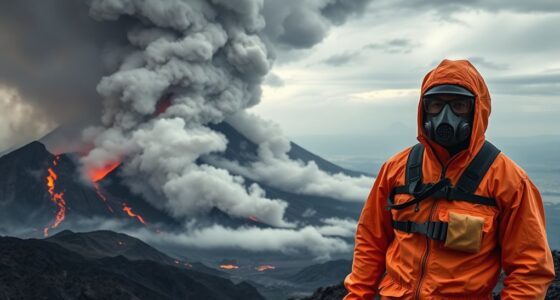A tsunami is a series of large ocean waves caused by sudden undersea earthquakes, volcanic eruptions, or landslides. To recognize warnings, watch for signs like a strong, long earthquake, water receding from the shore, or a loud roaring noise from the ocean. If you notice these, immediately move inland or to higher ground using established routes. Staying alert and prepared can save your life, and continuing will help you understand how to stay safe in such emergencies.
Key Takeaways
- Recognize natural warnings like strong earthquakes, sudden water retreat, and loud roaring sounds as signs of an impending tsunami.
- Move immediately inland or to higher ground upon detecting any tsunami warning signs; do not wait to see the waves.
- Familiarize yourself with local evacuation routes and community shelters before a tsunami occurs.
- Keep an emergency kit ready with essentials such as water, food, flashlight, and radio for quick evacuation.
- Stay calm, act swiftly, and avoid the shoreline during alerts to increase safety and survival chances.

A tsunami is a series of powerful ocean waves caused by sudden disturbances like undersea earthquakes, volcanic eruptions, or landslides. When one of these events occurs beneath or near the ocean, it displaces a large volume of water, sending waves rushing outward in all directions. Unlike regular waves, which are caused by wind and are relatively small, tsunamis are massive and can travel across entire ocean basins at speeds up to 500 miles per hour. As they approach shallow coastal areas, the waves slow down but grow taller, sometimes reaching heights of 100 feet or more, making them incredibly destructive.
Understanding natural warnings is essential to stay safe. One of the clearest signs of an impending tsunami is a sudden, intense earthquake that lasts for 20 seconds or more. If you feel the ground shake strongly or see the water recede unexpectedly from the shore, you should immediately recognize this as a warning sign. Often, the water pulls away from the coast hours before the waves arrive, exposing seabeds, boats, and debris. This unusual retreat is a critical signal that a tsunami may be imminent. Other signs include a loud roaring noise from the ocean or the appearance of a rapidly advancing wall of water. However, not all tsunamis are preceded by obvious signs, which is why awareness and preparedness are crucial.
Recognize early signs like strong quakes and receding water to stay safe from tsunamis.
If you find yourself in a coastal area when you notice these warnings, your first priority is to move inland and to higher ground immediately. Do not wait to see the waves; every minute counts. Use your knowledge of local evacuation routes, which are usually marked and designated by authorities, to reach a safe location. These routes are planned to get you away from the shoreline quickly and safely, often leading to community shelters or designated high ground. If you’re in a boat or near the water when an alert is issued, head out to open water if possible, as being offshore can be safer than staying close to the coast.
Preparation is key to surviving a tsunami. Familiarize yourself with local evacuation routes and tsunami warning systems before an emergency occurs. Keep an emergency kit ready with essentials like water, food, a flashlight, and a radio. Remember that during a tsunami warning, staying calm and acting swiftly can save your life. Never attempt to surf or watch the waves from the shoreline once a warning is issued; instead, prioritize moving to safety as quickly as possible. By understanding natural warnings and knowing your evacuation routes, you greatly increase your chances of avoiding the destructive power of a tsunami.
Frequently Asked Questions
How Long Does a Typical Tsunami Warning Last?
A typical tsunami warning lasts from a few minutes to several hours, depending on the event’s scale and location. When you get a warning, act quickly—evacuate immediately and move to higher ground. Authorities constantly monitor the situation, and updates may extend or cancel warnings. Stay alert, follow official instructions, and don’t return until authorities confirm it’s safe. Your swift response can save your life during a tsunami threat.
Can Animals Sense an Approaching Tsunami?
Yes, animals can often sense an approaching tsunami before humans do. They respond to subtle natural signs like changes in water movement, strange noises, or unusual animal behavior. You might notice birds flying erratically or animals retreating to higher ground. These reactions happen because animals have heightened senses that pick up on vibrations or shifts in the environment, giving you an early warning sign to evacuate quickly.
Are Tsunamis Only Caused by Earthquakes?
Tsunamis aren’t caused only by earthquakes; they can also result from undersea landslides, volcanic eruptions, or even meteorite impacts. About 90% of tsunamis are triggered by undersea earthquakes, but other events can generate deadly waves too. So, if you hear natural warnings like a sudden ocean retreat or a loud roar, stay alert—tsunamis can happen from various sources, not just earthquakes. Always know your evacuation routes.
What Technology Is Used to Detect Tsunamis?
You can rely on tsunami detection technology like deep-ocean assessment and reporting of tsunamis (DART) buoys, which monitor ocean pressure and wave activity to identify potential tsunamis early. Coastal tide gauges also detect rising water levels, providing essential warnings. Satellite systems and seismic sensors help confirm the occurrence of undersea earthquakes that might trigger tsunamis. Together, these technologies enable authorities to issue timely alerts and protect communities.
How Effective Are Tsunami Warning Sirens?
Tsunami warning sirens are quite effective at alerting you quickly when a tsunami threat is detected. They provide immediate, audible alerts that can reach large communities, prompting you to evacuate promptly. However, their effectiveness relies on proper maintenance, clear sound levels, and public awareness of what the signals mean. Always pay attention to local alerts and have a backup plan, since sirens alone can’t ensure everyone hears or understands the warning.
Conclusion
Now that you know the basics of tsunamis, you’re better prepared to recognize natural warnings and follow evacuation routes. Remember, your safety depends on acting quickly and staying informed. Don’t wait until it’s too late—are you ready to stay calm and move to higher ground if a tsunami strikes? By staying alert and prepared, you can protect yourself and others in these powerful moments of nature’s fury. Stay safe and always be prepared.










